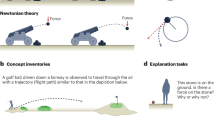Abstract
This study investigated whether intuitive, naive conceptions of “living things” based on objects’ mobility (movement = alive) persist into adolescence and affect 10th graders’ accuracy of responses and reaction times during object classification. Most of the 58 students classified the test objects correctly as living/nonliving, yet they demonstrated significantly longer reaction times for classifying plants compared to animals and for classifying dynamic objects compared to static inanimate objects. Findings indicated that, despite prior learning in biology, the intuitive conception of living things persists up to age 15–16 years, affecting related reasoning processes. Consideration of these findings may help educators in their decisions about the nature of examples they use in their classrooms.


Similar content being viewed by others
Explore related subjects
Discover the latest articles and news from researchers in related subjects, suggested using machine learning.References
Anderson CW, Smith EL (1987) Teaching science. In: Richardson-Koehler V (ed) Educators’ handbook: a research perspective. Longman, Inc, White Plains, NY, pp 84–111
Babai R, Amsterdamer A (2008) The persistence of solid and liquid naive conceptions: a reaction time study. J Sci Educ Technol 17:553–559
Babai R, Brecher T, Stavy R, Tirosh D (2006a) Intuitive interference in probabilistic reasoning. Int J Sci Math Edu 4:627–639
Babai R, Levyadun T, Stavy R, Tirosh D (2006b) Intuitive rules in science and mathematics: a reaction time study. Int J Math Edu Sci Technol 37:913–924
Brebner JT, Welford AT (1980) Introduction: an historical background sketch. In: Welford AT (ed) Reaction times. Academic Press, New York, pp 1–23
Carey S (1985) Conceptual change in childhood. MIT Press, Cambridge, MA
Duit R (2007). Students’ and teachers’ conceptions and science education: a bibliography, full version March 2007. Retrieved from http://www.ipn.uni-kiel.de/aktuell/stcse/stcse.html
Evans JBT, Over DE (1996) Rationality and reasoning. Psychology Press, Hove
Hatano G, Siegler R, Richards D, Inagaki K, Stavy R, Wax N (1993) The development of biological knowledge: a multi-national study. Cogn Dev 8:47–62
Hellden GF, Solomon J (2004) The persistence of personal and social themes in context: long- and short-term studies of students’ scientific ideas. Sci Educ 88:885–900
Inagaki K, Hatano G (1987) Young children’s spontaneous personification as analogy. Child Dev 58:1013–1021
Inagaki K, Hatano G (2006) Young children’s conception of the biological world. Curr Dir Psychol Sci 15:177–181
Laurendeau M, Pinard H (1962) Causal thinking in the child. International University Press, New York
McDermott LC (2001) Oersted medal lecture 2001: physics education research–the key to student learning. Am J Phys 69:1127–1138
Norenzayan A, Smith EE, Kim B, Nisbett RE (2002) Cultural preferences for formal versus intuitive reasoning. Cogn Sci 26:653–684
Opfer JE, Siegler RS (2004) Revisiting preschoolers’ living things concept: a microgenetic analysis of conceptual change in basic biology. Cogn Psychol 49:301–332
Palmeri TJ, Noelle D (2002) Concept learning. In: Arbib MA (ed) The handbook of brain theory and neural networks. MIT Press, Cambridge, MA, pp 234–238
Piaget J (1929) The child’s conception of the world. Harcourt Brace, Oxford, UK
Sloman S (1996) The empirical case for two systems of reasoning. Psychol Bull 119:30–32
Stavy R (1994) States of matter–pedagogical sequence and teaching strategies based on cognitive research. In: Fensham PJ, Gunstone RF, White RT (eds) The content of science: a constructivist approach to its teaching and learning. Falmer, London, pp 221–236
Stavy R, Tirosh D (2000) How students (mis-)understand science and mathematics: intuitive rules. Teachers College Press, New York
Stavy R, Wax N (1989) Children’s conceptions of plants as living things. Hum Dev 32:88–94
Tamir P, Gal-Chappin R, Nussnovitz R (1981) How do intermediate and junior high school students conceptualize living and nonliving? J Res Sci Teach 18:241–248
Tversky A, Kahneman D (1983) Extensional versus intuitive reasoning: the conjunction fallacy in probability judgment. Psychol Rev 90:293–315
Waxman S (2005) Why is the concept “living thing” so elusive? Concepts, languages, and the development of folk biology. In: Ahn W, Goldstone RL, Love BC, Markman AB, Wolff P (eds) Categorization inside and outside the laboratory: essays in honor of Douglas L. Medin. American Psychological Association, Washington, DC, pp 49–67
White RT, Gunstone RF (1989) Metalearning and conceptual change: special issue. Int J Sci Edu 11:577–586
Author information
Authors and Affiliations
Corresponding author
Rights and permissions
About this article
Cite this article
Babai, R., Sekal, R. & Stavy, R. Persistence of the Intuitive Conception of Living Things in Adolescence. J Sci Educ Technol 19, 20–26 (2010). https://doi.org/10.1007/s10956-009-9174-2
Received:
Accepted:
Published:
Issue Date:
DOI: https://doi.org/10.1007/s10956-009-9174-2




